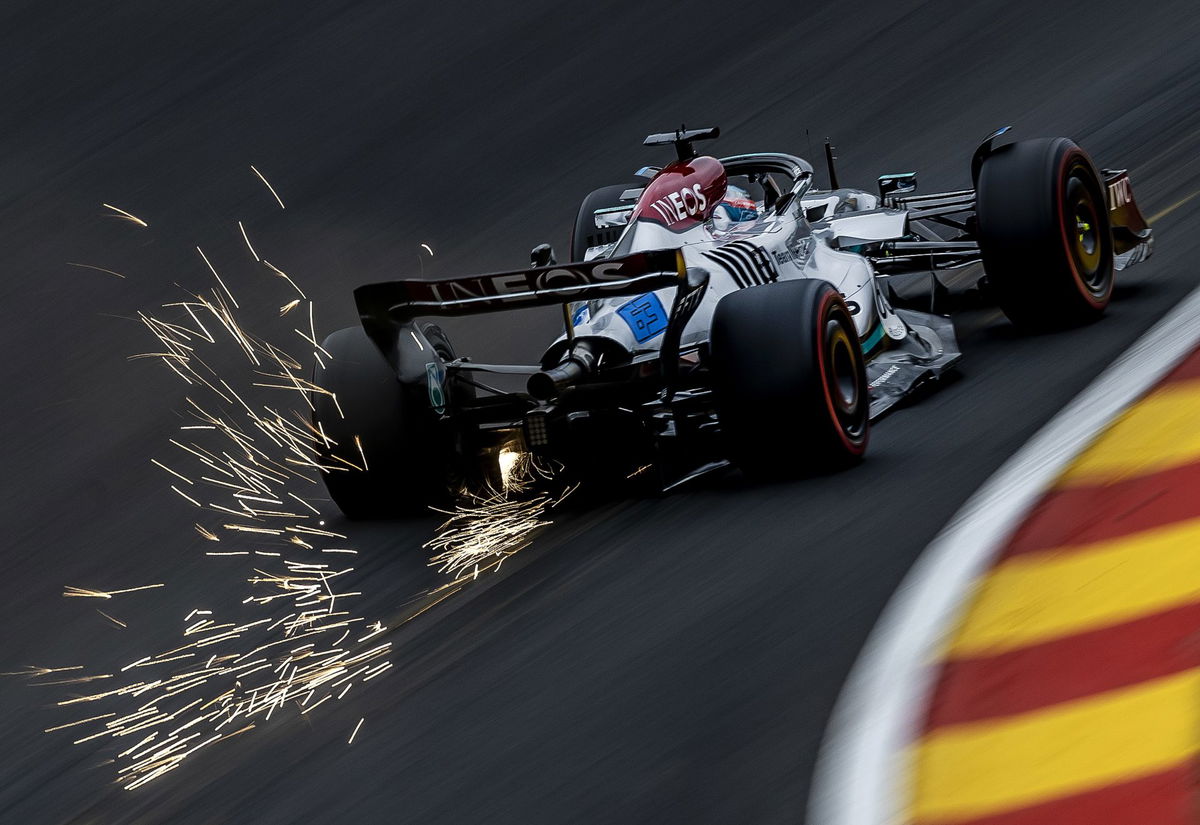
Getty
SPA – George Russell (63) with the Mercedes W13 during the 2nd free practice session ahead of the F1 Grand Prix of Belgium at the Circuit de Spa-Francorchamps on August 26, 2022 in SPA, Belgium. REMKO DE WAAL (Photo by ANP via Getty Images)

Getty
SPA – George Russell (63) with the Mercedes W13 during the 2nd free practice session ahead of the F1 Grand Prix of Belgium at the Circuit de Spa-Francorchamps on August 26, 2022 in SPA, Belgium. REMKO DE WAAL (Photo by ANP via Getty Images)
Formula 1 is the premium form of motorsport. Being the pinnacle form, F1 uses some of the most advanced technology in every possible aspect. Fuel is no exception. However, the fuel F1 cars use does not differ too much from that of any road car.
Watch What’s Trending Now!
ADVERTISEMENT
With that said, the type of fuel F1 cars use isn’t what we generally see at gas stations. They are slightly different as these fuels are specifically regulated by the directions of the FIA, governing body for motorsport all over the world.
With the new rules and regulations slated in from the 2022 F1 season, F1 cars started using bio-fuels known as E-10 fuel. In the words of F1’s Chief Technical Officer Pat Symonds, these fuels are also known as ‘advanced sustainable fuels.’
ADVERTISEMENT
READ MORE: Lewis Hamilton-Max Verstappen Abu Dhabi Climax Labelled A ;Beautiful Satisfaction
F1 uses these fuels as they tend to work more towards the environmental cause. Burning normal petrol or gas harms the planet. Hence, the F1 governing body has put out strict guidelines on the type of fuel to be used.
ADVERTISEMENT
What are biofuels?
According to a report published by Formula 1 in 2019, the bio-fuels are of three generations. The first generation has fuel made mostly from food stock. These crops are specially grown to make fuels. However, this generation of fuels brought ethical issues and wasn’t sustainable.
The second generation of bio-fuels is made from the husks of corn as it is food waste. Moreover, it at times uses forestry waste or household waste. Lastly, the third-generation bio-fuels are known as e-fuels or synthetic fuels. They are the most advanced form of biofuels.
ADVERTISEMENT
Formula 1 is on track to be a net-zero carbon series by 2030, as well as switching to 100% sustainable fuel sources in 2026 with the new generation hybrid engines 👏🌎#F1 #Autosport pic.twitter.com/vo52vgBZdD
— Autosport (@autosport) June 27, 2022
Talking about the third generation bio-fuels, Symonds conveyed, “they’re often called drop-in fuels because you can effectively just put them into any engine, without modification, whereas engines that run on extreme ethanol mixes, such as used in Brazil [for road cars], require alteration.”
Top Stories
Adrian Newey’s Motorsport Masterpiece: RB17 vs Aston Martin Valkyrie, Which One Is Better?

Who Is Oscar Piastri’s Father, Chris Piastri? Co-Founder of Multibillion Dollar Automotive Company

3 Years After His Death, Niki Lauda’s Wife Brutally Disrespects Him to Initiate $32,000,000 Battle Against Own Children

Carlos Sainz & Ex Girlfriend Isa Hernaez Issue Contrasting Statements to Stir the Pot After Unexpected Breakup

Who Is Canadian F1 Billionaire Lawrence Stroll’s Daughter & Heiress Chloe Stroll?

ADVERTISEMENT
What else do we know about F1 fuel?
As mentioned earlier, the F1 cars use E-10 fuel, where E stands for ethanol and 10 refers to the percentage in the mixture. As the development is in progress, talks are on to make 100% sustainable fuels. Moreover, the Formula 1 authority believes to have a sustainability strategy that targets a net-zero carbon footprint by 2030.
READ MORE: Charles Leclerc Desires Unique Privilege Given To Max Verstappen For 2021 F1 Efforts
Talking about this, Symonds conveyed in 2019, “The path to that is not completely clear at the moment, but in partnership with the FIA and with the help of the engine manufacturers and the fuel companies, we are looking at the way forward.”
ADVERTISEMENT
Why use fuel instead of going electric?
The world has rapidly accustomed itself to electrification. From cars, and bikes to other forms of transport, electrification has grasped the globe. However, F1 does not believe in the same path.
Even though there is Formula E that has electric single-seater open-wheeled cars, that’s not exactly F1. The F1 CTO revealed why Formula 1 isn’t going electric. Talking about this, F1 CTO shared his thoughts on the upcoming fully sustainable fuel and how F1 can stick to using bio-fuels in an environment-friendly way.
ADVERTISEMENT
No better demonstration or advertisement for the potential that exists in a fossil fuel free future. And all on a weekend where F1 recommitted its pledge to run 100% synthetic sustainable fuel with new engine regs in 26, and carbon neutrality by 2030. pic.twitter.com/s6H3Sv1Y5L
— Will Buxton (@wbuxtonofficial) July 4, 2022
In a report published by F1, Pat Symonds stated, “What we can do is we can show the world that there are alternatives to electric power and there are alternatives to storing electricity in heavy and, I have to say, somewhat dirty batteries.”
WATCH THIS STORY: How Fast Can F1 Cars Go? Comparisons With MotoGP, IndyCAR, NASCAR and Formula E
ADVERTISEMENT
All in all, F1 uses bio-fuels that are specifically developed and are not easily available to be purchased in the marketplace.
ADVERTISEMENT
ADVERTISEMENT
ADVERTISEMENT

